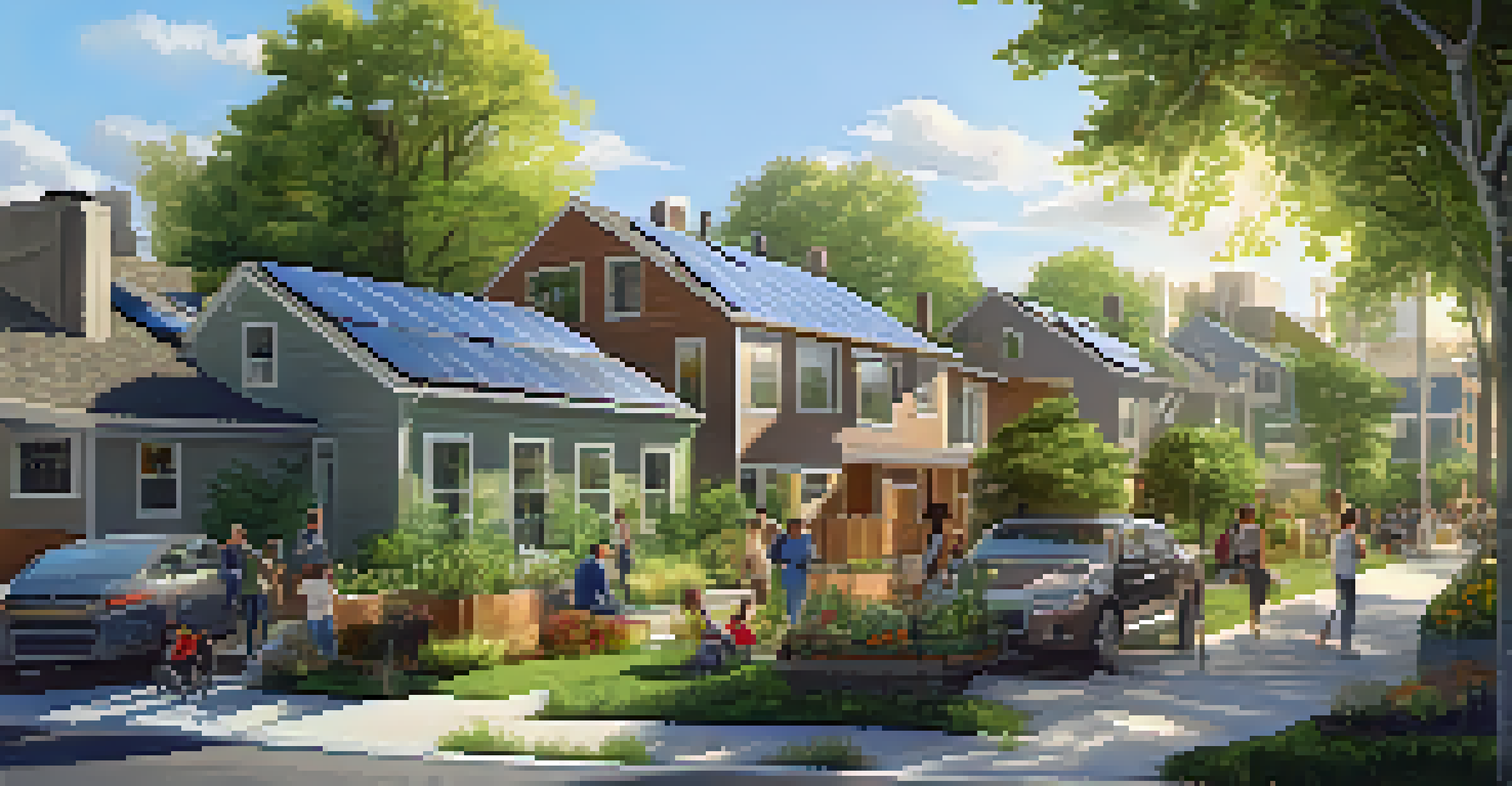The Impact of Climate Change on Real Estate Values

Understanding Climate Change and Its Real Estate Effects
Climate change refers to long-term shifts in temperatures and weather patterns, primarily driven by human activities. These changes can have far-reaching effects, especially on real estate. Properties in coastal areas, for instance, are increasingly at risk due to rising sea levels and more frequent storms, which can significantly impact their value.
Climate change is no longer some far-off problem; it is happening here, it is happening now.
As extreme weather events become more common, buyers are becoming more cautious, often avoiding properties in high-risk areas. This shift in buyer behavior can lead to a decline in demand, ultimately affecting property prices. It's crucial for potential buyers and investors to understand these risks before making real estate decisions.
Furthermore, the implications of climate change are not uniform; they vary by region. In some areas, properties might see a rise in value due to increased demand for climate-resilient features, while in others, values may plummet due to environmental vulnerabilities.
The Role of Insurance in Real Estate Valuation
Insurance plays a vital role in the real estate market, particularly as climate change increases risk exposure. Properties in areas prone to natural disasters often face higher insurance premiums, which can deter potential buyers. If insurance becomes unaffordable or unavailable, property values are likely to decrease, leading to a ripple effect in the local market.

Additionally, lenders are becoming more cautious about financing properties in high-risk areas. If buyers cannot secure favorable loan terms due to insurance concerns, demand for these properties will decline. This scenario underscores the interconnectedness of insurance and real estate values in the face of climate change.
Climate Change Affects Property Values
Rising sea levels and extreme weather events are leading to shifts in buyer behavior and property demand, impacting real estate values.
As homeowners and investors increasingly factor in these risks, the demand for properties with lower insurance costs may rise. This shift can create a bifurcation in the market, where climate-resilient homes appreciate while others lose value.
Shifts in Buyer Preferences Due to Climate Awareness
As awareness of climate change grows, so do buyer preferences. Many homebuyers are now actively seeking properties that are energy-efficient or located in sustainable communities. This trend reflects a desire to reduce their carbon footprint and invest in homes that will retain value in a changing climate.
The best time to plant a tree was 20 years ago. The second best time is now.
Real estate developers are responding to this shift by incorporating eco-friendly features and sustainable practices into their projects. From solar panels to green roofs, these enhancements not only appeal to environmentally conscious buyers but can also lead to higher property values. Such developments can differentiate themselves in a crowded market, driving demand.
Moreover, communities that prioritize sustainability are becoming increasingly attractive. Buyers are looking for neighborhoods that offer green spaces, efficient public transportation, and active climate initiatives, further impacting property values in those areas.
Regulatory Changes and Their Impact on Real Estate
Governments worldwide are implementing regulations aimed at combating climate change, and these can significantly impact real estate values. For instance, stricter building codes that promote energy efficiency can raise construction costs but may ultimately lead to higher property values over time. Buyers are often willing to pay a premium for homes that meet these new standards.
On the flip side, properties that do not comply with new regulations may face penalties or decreased marketability. If a home is deemed non-compliant, it may struggle to attract buyers, leading to a decline in value. As regulations evolve, understanding local policies becomes crucial for anyone involved in real estate.
Insurance Influences Market Stability
Higher insurance premiums in high-risk areas can deter buyers and decrease property values, highlighting the link between insurance and real estate.
Additionally, local governments may invest in infrastructure that mitigates climate risks, such as improved drainage systems or flood defenses. These enhancements can bolster property values in affected areas, creating a more resilient market.
The Economic Impact of Climate Change on Real Estate Markets
The economic implications of climate change extend far beyond individual properties, affecting entire real estate markets. Areas that experience frequent flooding or wildfires may see a decrease in overall market stability. As these events become more common, investors may become wary, leading to decreased investment in these regions.
Furthermore, climate change can disrupt local economies, impacting job markets and, consequently, housing demand. If businesses relocate away from high-risk areas, property values can decline, creating a vicious cycle that further destabilizes the market. Investors need to keep these economic factors in mind when evaluating real estate opportunities.
Conversely, areas that develop robust climate adaptation strategies may attract new residents and businesses, boosting real estate values. A proactive approach to climate resilience can create a competitive advantage in the real estate market.
Technological Innovations and Climate Resilience
Technology is playing an increasingly important role in enhancing climate resilience within the real estate sector. Innovations such as advanced modeling tools help predict climate impacts, enabling developers and investors to make informed decisions. This proactive approach can safeguard property values by minimizing risk exposure.
Moreover, smart home technologies can improve energy efficiency, making properties more appealing to environmentally conscious buyers. Features like smart thermostats and energy-efficient appliances not only contribute to sustainability efforts but can also lead to cost savings for homeowners, increasing overall property desirability.
Sustainable Homes Drive Buyer Interest
As more buyers seek energy-efficient and sustainable properties, real estate developers are adapting to meet this demand, potentially increasing property values.
As technology continues to evolve, it will likely shape buyer expectations and preferences. Properties equipped with the latest climate-resilient technologies may command higher prices, underscoring the importance of staying ahead in a rapidly changing market.
The Long-Term Outlook for Real Estate Values
Looking ahead, the long-term outlook for real estate values will heavily depend on how communities and investors adapt to the realities of climate change. Areas that take proactive measures to enhance resilience and sustainability are likely to see stable or even rising property values. Conversely, regions that ignore these challenges may face significant declines.
Investors should consider not only current market conditions but also future climate scenarios when evaluating property investments. Understanding the potential impacts of climate change will be crucial for making informed decisions that protect and grow asset values over time.

Ultimately, adaptability will be key in navigating this evolving landscape. By embracing climate resilience and sustainability, stakeholders can better position themselves for success in a world where climate change is an ever-present reality.